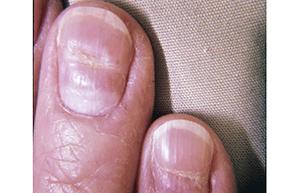In the intricate tapestry of human health, our nails often serve as the unsung heroes, quietly narrating stories about our overall well-being. Much like the rings of a tree, they can reveal hidden tales of neglect, stress, or underlying medical conditions. Yet, despite their vital role, the warning signs etched onto these keratin canvases often go unnoticed until significant damage has taken root. As custodians of our own health, understanding the subtle language of our nails is crucial. This article delves into the essential indicators that your nails might be waving a red flag, guiding you through the art of recognizing serious damage before it escalates. Prepare to embark on a journey beneath the surface, where every ridge, discoloration, and brittle edge tells a story worth listening to.
Spotting the Subtle Signs of Nail Deterioration: What to Look For

When it comes to identifying early signs of nail damage, the devil is in the details. The health of your nails can reveal much about your overall well-being, so it’s crucial to be vigilant. Discoloration is one of the first signs you might notice. While minor color changes can be harmless, a consistent yellowing or darkening could indicate a more serious issue such as a fungal infection or even underlying health conditions. Keep an eye out for texture changes as well. Healthy nails are generally smooth, so if you observe ridges, dents, or pits forming, it might be time to investigate further.
- Splitting and Peeling: Frequent splitting or peeling of nails could be a sign of dryness or a deficiency in essential nutrients like biotin.
- Thinning or Thickening: Nails that become unusually thin or thick could indicate hormonal imbalances or fungal infections.
- Brittleness: Easily broken or cracked nails may suggest overexposure to water or harsh chemicals.
- Swelling and Redness: If the skin around your nails is swollen or red, it could point to an infection or inflammatory condition.
By paying close attention to these subtle indicators, you can take proactive steps to maintain the health and beauty of your nails. Don’t underestimate the power of regular nail inspections in preventing long-term damage.
Unveiling the Causes: Understanding Why Your Nails Are at Risk

Delving into the intricacies of nail health reveals a fascinating interplay of factors that can lead to damage. From environmental influences to lifestyle choices, understanding these causes is crucial for maintaining strong, healthy nails. One of the primary culprits is exposure to harsh chemicals, often found in cleaning products or even certain nail care items. These chemicals can strip your nails of their natural oils, leaving them brittle and prone to splitting.
Another significant factor is nutritional deficiencies. A lack of essential vitamins and minerals, such as biotin, iron, and zinc, can lead to weakened nails. Additionally, habits like frequent nail biting or improper nail grooming can exacerbate damage. Here are some common contributors to nail health issues:
- Prolonged water exposure
- Overuse of acrylic nails or gel manicures
- Inadequate hydration
- Medical conditions like thyroid disorders or psoriasis
By recognizing these underlying causes, you can take proactive steps to protect your nails from further harm and ensure they remain robust and beautiful.
Taking Action: Expert-Recommended Steps to Restore Nail Health
When your nails begin to exhibit signs of serious damage, it’s crucial to act promptly to restore their health. Leading experts suggest a multi-faceted approach to nail care that combines both external treatments and lifestyle adjustments. Begin by moisturizing regularly with a high-quality nail oil or cream that contains ingredients like vitamin E or jojoba oil. These nutrients penetrate deeply, promoting flexibility and preventing brittleness.
- Trim and file carefully: Ensure nails are kept at a manageable length to prevent snagging and breakage. Use a fine-grit file and move in one direction to avoid further damage.
- Protect your nails: Wear gloves when doing household chores, especially those involving water and harsh chemicals.
- Enhance your diet: Incorporate foods rich in biotin, zinc, and omega-3 fatty acids. Think avocados, almonds, and salmon to support nail growth from within.
- Avoid harsh products: Refrain from using acetone-based nail polish removers and opt for gentler alternatives.
- Seek professional advice: If the condition persists, consult a dermatologist to rule out underlying health issues.
These expert-recommended strategies not only halt further damage but also set the foundation for robust, resilient nails. By taking these steps, you’re investing in long-term nail health that radiates vitality and strength.
Final Thoughts
As we conclude our exploration into the world of nail health, remember that your nails are more than just aesthetic accessories; they are barometers of your overall well-being. By recognizing the subtle signs of distress—be it discoloration, brittleness, or unexpected texture changes—you hold the key to preemptive care and healing. Armed with this knowledge, you’re now equipped to not only observe but also act with precision and confidence. Let your newfound awareness guide you in nurturing your nails back to their natural resilience, ensuring they remain as strong and vibrant as the life you lead. So, take a moment, examine your fingertips, and embrace the power of informed vigilance. After all, healthy nails are not just a reflection of self-care; they are a testament to your attentiveness and commitment to the harmony of your body’s intricate symphony.


